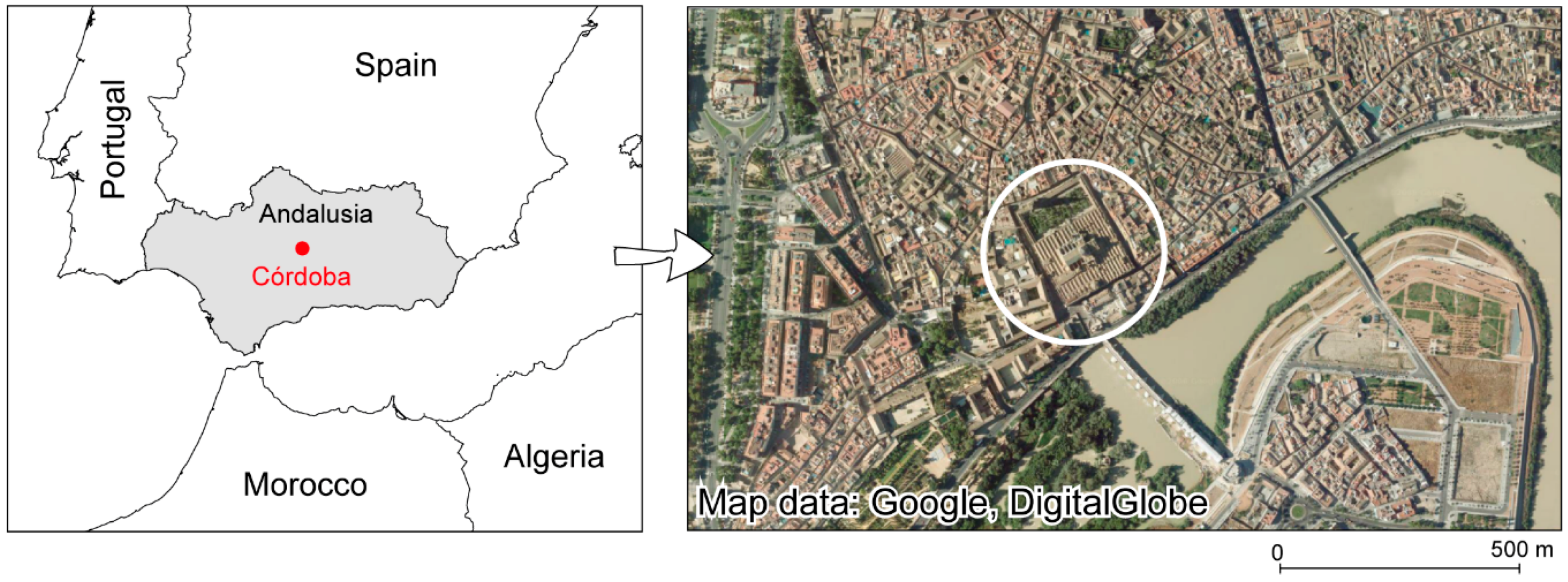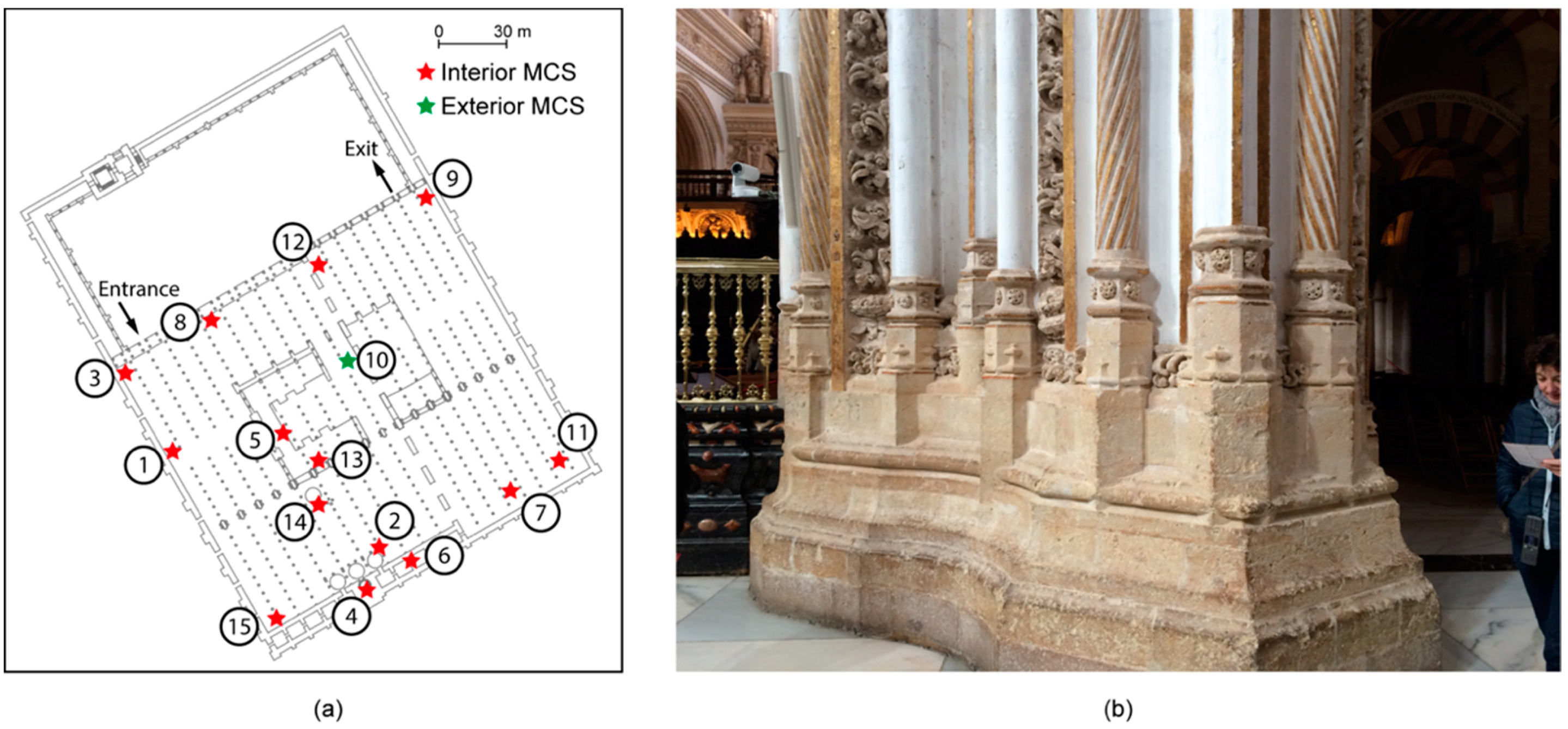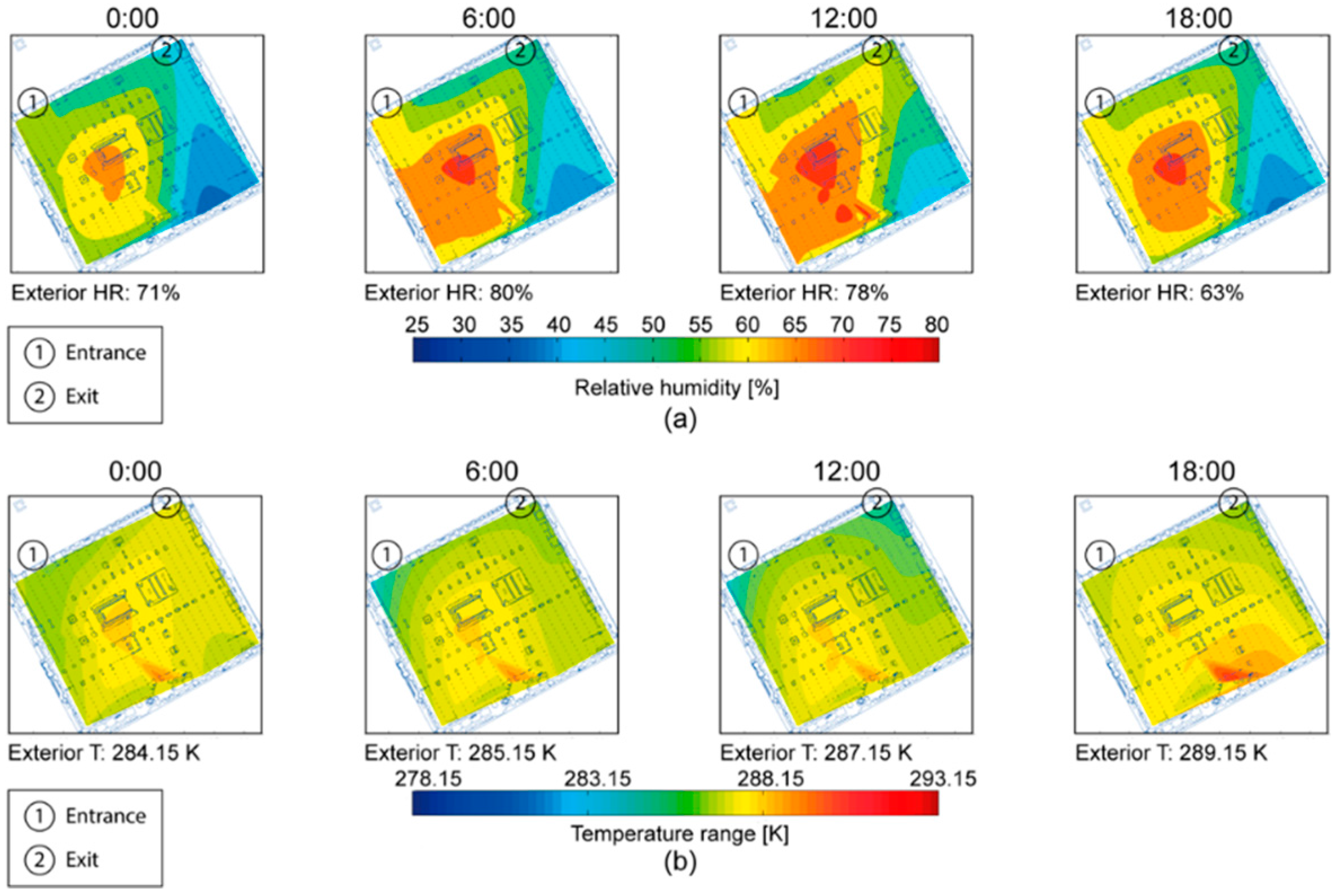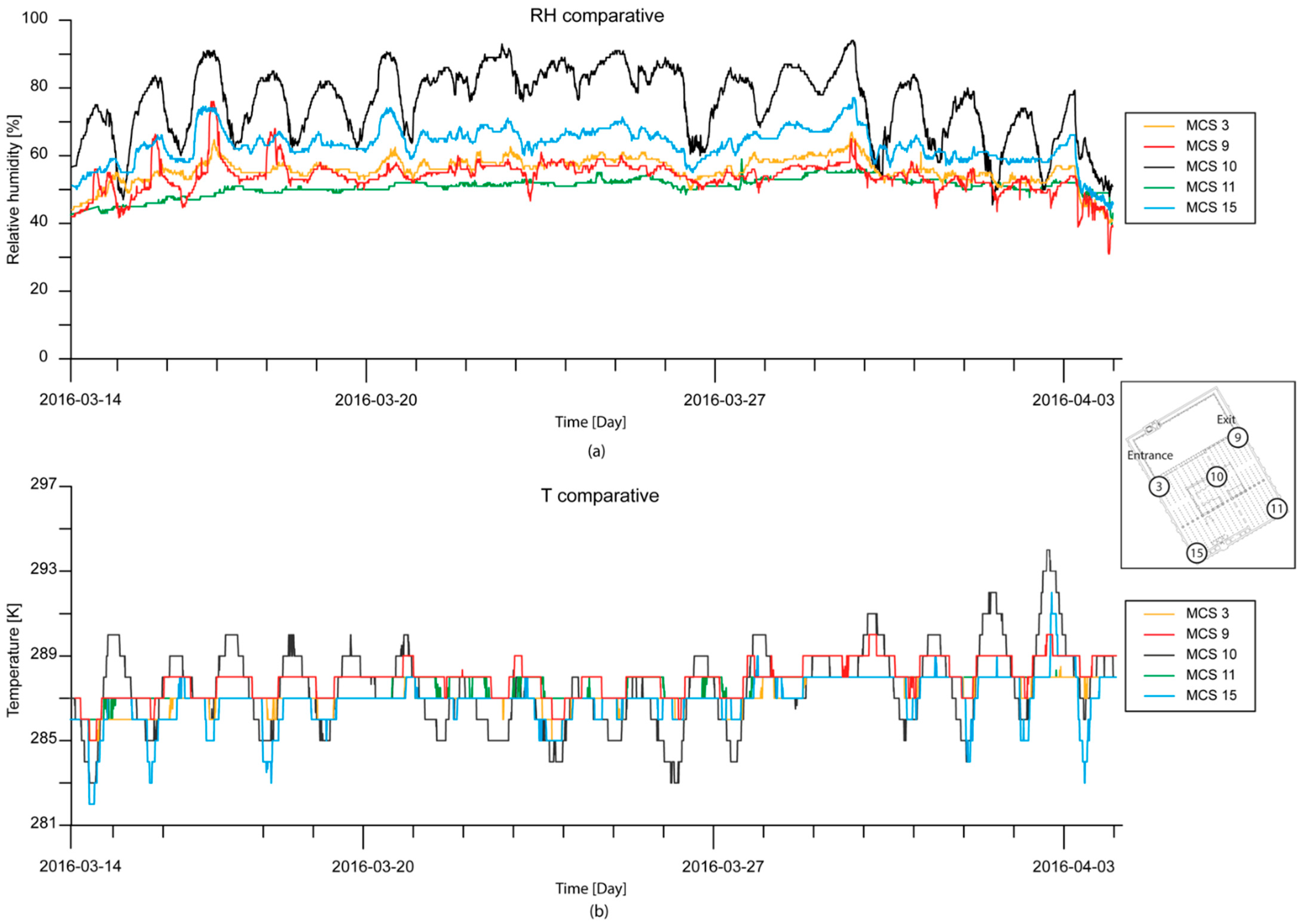Monitoring Heritage Buildings with Open Source Hardware Sensors: A Case Study of the Mosque-Cathedral of Córdoba
Abstract
:1. Introduction
2. Description of the Mosque-Cathedral of Córdoba
3. Materials and Methods
3.1. Monitoring System
3.2. Data
4. Case Study and Experimental Results
5. Conclusions
Acknowledgments
Author Contributions
Conflicts of Interest
Abbreviations
| MCS | Microclimate station |
| OSH | Open source hardware |
| RH | Relative humidity |
| T | Temperature |
References
- Camuffo, D. Microclimate for Cultural Heritage; Elsevier: San Diego, CA, USA, 1998. [Google Scholar]
- Staniforth, S.; Griffin, I. Damp problems in the chapel at cliveden. In Proceedings of the Symposium on Conservation of Heritage Interiors, Ottawa, ON, Canada, 17–20 May 2000; pp. 177–184.
- Stewart, J.; Julien, S.; Staniforth, S. An Integrated Monitoring Strategy at Chedworth Roman Villa (Gloucestershire). In Proceedings of the 2nd Conference: Preserving Archaeological Remains in Situ? London, UK, 12–14 September 2001; pp. 179–187.
- Liu, B.; Chen, X.; Fang, D.; Perrone, A.; Pispas, S.; Vainos, N.A. Environmental monitoring by thin film nanocomposite sensors for cultural heritage preservation. J. Alloy Comp. 2010, 504, S405–S409. [Google Scholar] [CrossRef]
- Becherini, F.; Bernardi, A.; Frassoldati, E. Microclimate inside a semi-confined environment: Valuation of suitability for the conservation of heritage materials. J. Cult. Herit. 2010, 11, 471–476. [Google Scholar] [CrossRef]
- Varas-Muriel, M.J.; Martínez-Garrido, M.I.; Fort, R. Monitoring the thermal–hygrometric conditions induced by traditional heating systems in a historic spanish church (12th–16th c). Energy Build. 2014, 75, 119–132. [Google Scholar] [CrossRef]
- Lillie, M.; Smith, R.; Reed, J.; Inglis, R. Southwest scottish crannogs: Using in situ studies to assess preservation in wetland archaeological contexts. J. Archaeol. Sci. 2008, 35, 1886–1900. [Google Scholar] [CrossRef]
- Caragliu, A.; Del Bo, C.; Nijkamp, P. Smart cities in europe. J. Urb. Technol. 2011, 18, 65–82. [Google Scholar] [CrossRef]
- Allen, K.; Hollinworth, N.; Hwang, F.; Minnion, A.; Kwiatkowska, G.; Lowe, T.; Weldin, N. Interactive sensory objects for improving access to heritage. In Proceedings of the CHI ‘13 Extended Abstracts on Human Factors in Computing Systems, Paris, France, 27 April 2013; pp. 2899–2902.
- Saı̈d, M.N.A.; Brown, W.C.; Shirtliffe, C.J.; Maurenbrecher, A.H.P. Monitoring of the building envelope of a heritage house: A case study. Energy Build. 1999, 30, 211–219. [Google Scholar] [CrossRef]
- Neri, A.; Corbellini, S.; Parvis, M.; Arcudi, L.; Grassini, S.; Piantanida, M.; Angelini, E. Environmental monitoring of heritage buildings. In Proceedings of the IEEE Workshop on the Environmental, Energy, and Structural Monitoring Systems, 2009, Crema, Italy, 25–25 September 2009; pp. 93–97.
- Ascione, F.; Bellia, L.; Capozzoli, A.; Minichiello, F. Energy saving strategies in air-conditioning for museums. Appl. Therm. Eng. 2009, 29, 676–686. [Google Scholar] [CrossRef]
- Camuffo, D.; Pagan, E.; Bernardi, A.; Becherini, F. The impact of heating, lighting and people in re-using historical buildings: A case study. J. Cult. Heri. 2004, 5, 409–416. [Google Scholar] [CrossRef]
- La Gennusa, M.; Rizzo, G.; Scaccianoce, G.; Nicoletti, F. Control of indoor environments in heritage buildings: Experimental measurements in an old italian museum and proposal of a methodology. J. Cult. Herit. 2005, 6, 147–155. [Google Scholar] [CrossRef]
- Valero, M.Á.; Merello, P.; Navajas, Á.F.; García-Diego, F.-J. Statistical tools applied in the characterisation and evaluation of a thermo-hygrometric corrective action carried out at the noheda archaeological site (noheda, spain). Sensors 2014, 14, 1665–1679. [Google Scholar] [CrossRef] [PubMed]
- Bøe Sollund, M.-L.; Holm-Olsen, I.M. Monitoring cultural heritage in a long-term project: The norwegian sequential monitoring programme. Conserv. Manag. Archaeol. Sites 2013, 15, 137–151. [Google Scholar] [CrossRef]
- Mesas-Carrascosa, F.J.; Verdú Santano, D.; Meroño, J.E.; Sánchez de la Orden, M.; García-Ferrer, A. Open source hardware to monitor environmental parameters in precision agriculture. Biosyst. Eng. 2015, 137, 73–83. [Google Scholar] [CrossRef]
- Camuffo, D.; Bernardi, A.; Sturaro, G.; Valentino, A. The microclimate inside the pollaiolo and botticelli rooms in the uffizi gallery, florence. J. Cult. Herit. 2002, 3, 155–161. [Google Scholar] [CrossRef]
- Merello, P.; García-Diego, F.-J.; Zarzo, M. Diagnosis of abnormal patterns in multivariate microclimate monitoring: A case study of an open-air archaeological site in pompeii (italy). Sci. Total Environ. 2014, 488–489, 14–25. [Google Scholar] [CrossRef] [PubMed]
- Koller, M. Learning from the history of preventive conservation. Stud. Conserv. 1994, 39, 1–7. [Google Scholar]
- Merello, P.; García-Diego, F.-J.; Zarzo, M. Microclimate monitoring of ariadne’s house (pompeii, italy) for preventive conservation of fresco paintings. Chem. Cent. J. 2012, 6, 145. [Google Scholar] [CrossRef] [PubMed] [Green Version]
- Fernández-Navajas, Á.; Merello, P.; Beltrán, P.; García-Diego, F.-J. Software for storage and management of microclimatic data for preventive conservation of cultural heritage. Sensors 2013, 13, 2700–2718. [Google Scholar] [CrossRef] [PubMed]
- Ferreiro, J.A.H.; Lorite, M.A.R. La conservación preventiva de las obras de arte. Arbor 1999, 164, 141. [Google Scholar] [CrossRef]
- Held, B.W.; Jurgens, J.A.; Arenz, B.E.; Duncan, S.M.; Farrell, R.L.; Blanchette, R.A. Environmental factors influencing microbial growth inside the historic expedition huts of ross island, antarctica. Int. Biodeterior. Biodegrad. 2005, 55, 45–53. [Google Scholar] [CrossRef]
- Fernández-Navajas, Á.; Merello, P.; Beltrán, P.; García-Diego, F.-J. Multivariate thermo-hygrometric characterisation of the archaeological site of plaza de l’almoina (valencia, spain) for preventive conservation. Sensors 2013, 13, 9729–9746. [Google Scholar] [CrossRef] [PubMed]
- Varas-Muriel, M.J.; Fort, R.; Martínez-Garrido, M.I.; Zornoza-Indart, A.; López-Arce, P. Fluctuations in the indoor environment in spanish rural churches and their effects on heritage conservation: Hygro-thermal and co2 conditions monitoring. Build. Environ. 2014, 82, 97–109. [Google Scholar] [CrossRef]
- Diego, F.-J.G.; Esteban, B.; Merello, P. Design of a hybrid (wired/wireless) acquisition data system for monitoring of cultural heritage physical parameters in smart cities. Sensors 2015, 15, 7246–7266. [Google Scholar] [CrossRef] [PubMed]
- Faugel, H.; Bobkov, V. Open source hard-and software: Using arduino boards to keep old hardware running. Fusion Eng. Des. 2013, 88, 1276–1279. [Google Scholar] [CrossRef]
- Thomson, K.E.; White, H.S. A novel open-source drug-delivery system that allows for first-of-kind simulation of nonadherence to pharmacological interventions in animal disease models. J. Neurosci. Methods 2014, 238, 105–111. [Google Scholar] [CrossRef] [PubMed]
- Gomaa, R.; Adly, I.; Sharshar, K.; Safwat, A.; Ragai, H. Zigbee wireless sensor network for radiation monitoring at nuclear facilities. In Proceedings of the Wireless and Mobile Networking Conference (WMNC), 2013 6th Joint IFIP, Dubai, United Arab Emirates, 23–25 April 2013; pp. 1–4.
- Leccese, F.; Cagnetti, M.; Calogero, A.; Trinca, D.; Pasquale, S.D.; Giarnetti, S.; Cozzella, L. A new acquisition and imaging system for environmental measurements: An experience on the italian cultural heritage. Sensors 2014, 14, 9290–9312. [Google Scholar] [CrossRef] [PubMed]
- Arduino Uno R3 Datasheet. Available online: https://www.arduino.cc/en/Main/ArduinoBoardUno (accessed on 29 March 2016).
- Conservation of Cultural Property-Specifications for Temperature and Relative Humidity to Limit Climate-Induced Mechanical Damage in Organic Hygroscopic Materials; ISO EN 15757:2011; European Committee for Standardization: Brussels, Belgium, 2011.
- Conservation of Cultural Property-Procedures and Instruments For Measuring Temperatures of the Air and The Surfaces Of Objects; ISO EN 15758:2011; European Committee for Standardization: Brussels, Belgium, 2011.
- Camuffo, D.; Fernicola, V.; Havermans, J. Basic Environmental Mechanisms Affecting Cultural Heritage:Understanding Deterioration Mechanisms for Conservation Purposes; Nardini Editore: Firenze, Italy, 2010. [Google Scholar]
- Dht22 Sensor Datasheet. Available online: https://www.adafruit.com/products/385 (accessed on 15 June 2016).
- Rtc Ds 1307 Sensor Datasheet. Available online: http://datasheets.maximintegrated.com/en/ds/DS1307.pdf (accesed on 15 June 2016).
- Barroca, N.; Borges, L.M.; Velez, F.J.; Monteiro, F.; Górski, M.; Castro-Gomes, J. Wireless sensor networks for temperature and humidity monitoring within concrete structures. Constr. Build. Mater. 2013, 40, 1156–1166. [Google Scholar] [CrossRef]
- Zítek, P.; Vyhlídal, T. Model-based moisture sorption stabilization in historical buildings. Build. Environ. 2009, 44, 1181–1187. [Google Scholar] [CrossRef]








| Temperature (K) | Relative Humidity (%) | |||||||
|---|---|---|---|---|---|---|---|---|
| MCS | Min | Max | Mean | SD 1 | Min | Max | Mean | SD 1 |
| 3 | 284.15 | 289.15 | 286.45 | ±0.9 | 34.0 | 81.5 | 56.0 | ±7.3 |
| 9 | 278.15 | 292.15 | 285.95 | ±1.5 | 27.0 | 76.6 | 55.8 | ±8.0 |
| 11 | 285.15 | 292.15 | 287.05 | ±1.1 | 29.0 | 64.3 | 51.0 | ±8.0 |
| 15 | 283.15 | 289.45 | 287.05 | ±0.7 | 35.3 | 84 | 63.0 | ±5.0 |
| 10 | 279.15 | 294.15 | 286.05 | ±2.1 | 36 | 99 | 79.4 | ±12.7 |
© 2016 by the authors; licensee MDPI, Basel, Switzerland. This article is an open access article distributed under the terms and conditions of the Creative Commons Attribution (CC-BY) license (http://creativecommons.org/licenses/by/4.0/).
Share and Cite
Mesas-Carrascosa, F.J.; Verdú Santano, D.; Meroño de Larriva, J.E.; Ortíz Cordero, R.; Hidalgo Fernández, R.E.; García-Ferrer, A. Monitoring Heritage Buildings with Open Source Hardware Sensors: A Case Study of the Mosque-Cathedral of Córdoba. Sensors 2016, 16, 1620. https://doi.org/10.3390/s16101620
Mesas-Carrascosa FJ, Verdú Santano D, Meroño de Larriva JE, Ortíz Cordero R, Hidalgo Fernández RE, García-Ferrer A. Monitoring Heritage Buildings with Open Source Hardware Sensors: A Case Study of the Mosque-Cathedral of Córdoba. Sensors. 2016; 16(10):1620. https://doi.org/10.3390/s16101620
Chicago/Turabian StyleMesas-Carrascosa, Francisco Javier, Daniel Verdú Santano, Jose Emilio Meroño de Larriva, Rafael Ortíz Cordero, Rafael Enrique Hidalgo Fernández, and Alfonso García-Ferrer. 2016. "Monitoring Heritage Buildings with Open Source Hardware Sensors: A Case Study of the Mosque-Cathedral of Córdoba" Sensors 16, no. 10: 1620. https://doi.org/10.3390/s16101620






